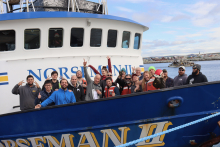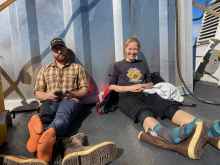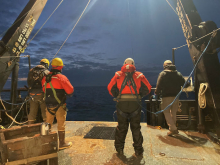Update
Update: In case you missed it, an archive is now available of Rebecca's live PolarConnect event aboard the Norseman II. You can view it on the PolarConnect Archives page.
What Are They Doing?
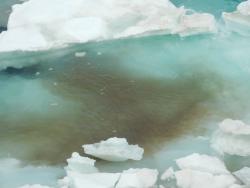
At the same time, little is known about the present and future risk from toxic algae to humans in the Pacific Arctic region. This study will be the first to document the current distribution of highly toxic HAB species over large spatial scales within the Alaskan Arctic and will provide estimates of areas at high risk of toxicity now and in a warming future. The hypothesis underlying this project is that HABs in Alaskan Arctic waters are not only transported from the south through Bering Strait but are now originating locally on the Chukchi shelf due to warming temperatures, circulation dynamics, and water mass structure. These factors influence bloom magnitude, duration, toxicity, and recurrence. This will be addressed through a joint physical-biological field and laboratory program to study the relationship between HAB species distribution/dynamics and the physical environment of the Chukchi Sea region.
The distribution of HAB species on the Chukchi shelf will be mapped in relation to hydrography and circulation, including a comprehensive survey of the Alaskan Coastal Current which transports the warmest water in the Chukchi Sea. A range of molecular and physiological tools will be used to investigate the origin, connectivity, and fate of HAB populations in the region. Sediment profiling will establish a historical record of blooms along the major transport pathways to the western Arctic. This information will be used to generate conceptual models of the origin, transport, and fate of HABs in the Chukchi Sea region.
Where Are They?
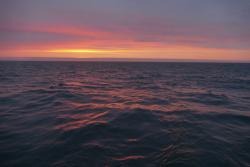
Latest Journals

Don Anderson is a Senior Scientist in the Biology Department of the Woods Hole Oceanographic Institution. He earned three degrees from MIT – a BS in Mechanical Engineering in 1970, and a MS (1975) and PhD in Civil and Environmental Engineering in 1977. He joined the scientific staff at WHOI in 1978. Anderson is the former director of WHOI’s Coastal Ocean Institute (COI), and presently serves as Director of the Cooperative Institute for North Atlantic Research (CINAR). Anderson also serves as Director of the U.S. National Office for Harmful Algal Blooms.
Anderson’s research focus is on toxic or harmful algal blooms (HABs), commonly called “red tides”. His research ranges from molecular and physiological studies of growth, sexuality, and toxin production to the large-scale oceanography and ecology of the “blooms” of these microorganisms, including numerical modeling, forecasting, and a range of monitoring and management strategies, many reliant on novel instrumentation and biosensors. Anderson is heavily involved in national and international program development for research, monitoring, and management of red tides, marine biotoxins, and HABs. He has testified nine times before Congressional committees, and has been actively involved in legislation and appropriations related to HABs and hypoxia.
Anderson is the author, co-author, or editor of over 330 scientific papers and 14 books.

Robert Pickart is a senior scientist in the Physical Oceanography Department at the Woods Hole Oceanographic Institution. His research focuses on high latitude processes, including air-sea interaction, deep convection, and shelf-basin exchange. He does fieldwork in both the Atlantic and Pacific sectors of the Arctic Ocean using a variety of techniques. Over the years he has led dozens of research expeditions, often with an outreach component for school children and the lay public.

Leah McRaven is a research associate in the Physical Oceanography Department at the Woods Hole Oceanographic Institution. Her work focuses on technical and research support for shipboard-based research programs. Leah is an expert in the collection and analysis of physical oceanographic measurements made at using ships and moorings (ocean temperature, salinity, and velocity). She regularly leads teams while in the field and has a passion for working through the challenges of the harsh Arctic environment. Over the years, she has sailed on 15 long-term research cruises that have taken her to locations ranging from the Equator to the Arctic.

Evie Fachon is a research assistant in the Anderson Laboratory at the Woods Hole Oceanographic Institution. She supports projects related to harmful algal bloom (HAB) distribution and dynamics, and first traveled to the Arctic in August 2018 to sample for toxic algal species aboard the US Coast Guard Cutter Healy. Since then, she has returned to Alaska two more times to continue this research, and has trained volunteers in HAB sampling for other expeditions. Back in the laboratory, she uses techniques such as fluorescence microscopy, culturing, and molecular analysis to learn more about the organisms that cause harmful blooms.


